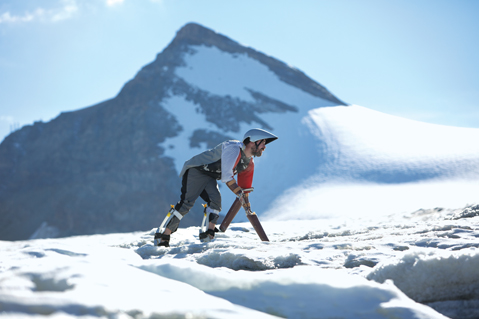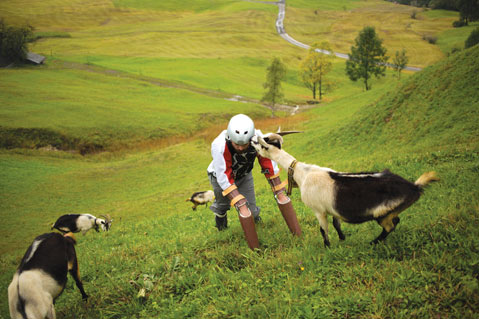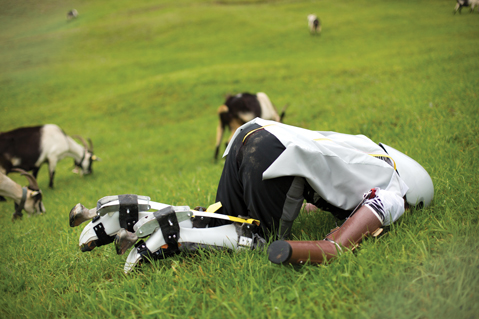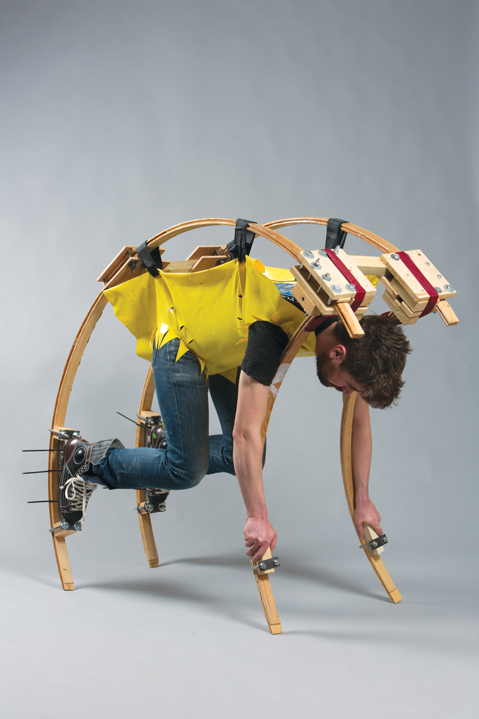Summer Reading: Beast Mode
Extreme Nature Writing Trespasses over the Species Divide

Summer reading, traditionally associated with lighter fare and school assignments, has grown up in recent years. Once the preserve of blockbuster novels like Jaws or The Bonfire of the Vanities, publisher’s spring and summer lists now often spawn unexpected best sellers such as Thomas Piketty’s Capital in the Twenty-First Century, 700 pages of erudite economic analysis that flew off the shelves from Memorial Day to Labor Day in 2014. Despite this appetite for seriousness in a significant segment of the audience, it’s likely that most summer readers still look for the literary equivalent of a holiday when selecting something for the summer — a book that will give them a break from more routine concerns and take them to places they haven’t been before.
In an effort to capture some of the wildest new books on offer in the summer of 2016, what follows charts the rise of an interesting new form of radical nature writing in which authors document their attempts to become more like animals, or, as the popular meme has it, enter into “beast mode.” Two major new nonfiction releases, GoatMan: How I Took a Holiday from Being Human (Princeton Architectural Press) by Thomas Thwaites and Being a Beast (Metropolitan Books) by Charles Foster, both involve what Foster in his subtitle calls “Adventures Across the Species Divide.” They offer detailed accounts of a variety of experiments designed to allow the authors a kind of privileged access to what it is like to be an animal.
Apart from a fascination with what’s on the other side of the species divide and a dedication to using real science to seek answers, the two books and their authors’ approaches to the task could hardly be more different. Foster is a Fellow of Green Templeton College, University of Oxford, and a qualified veterinarian with a doctorate in law and medical ethics from Cambridge. He’s also a married father of six and the author of previous books on biology, law, philosophy, travel, and spiritual experience. For the past several decades, Foster and his family have been participating in a variety of schemes he has invented to simulate the experience of being such animals as a badger, a red deer, a fox, an otter, and even a swift. By contrast, Thwaites comes to his GoatMan project from the world of design, and in particular from his own relatively short history as an expert on sustainability and technology. Foster, or at least his persona as a writer, knows a lot about nearly everything. He’s as comfortable with tracing etymologies to Old Irish as he is citing the latest research from such journals as Applied Animal Behaviour Science, and he writes like a dream. Thwaites, on the other hand, plays his youthful naiveté for laughs, offering half a dozen stories about how shocked some expert or other was by his frequently abrupt and seemingly absurd inquiries. Yet once he’s gotten a cloven hoof in the door, Thwaites proves to be a remarkably persistent researcher, and most of the people who scoff at him in the beginning end up becoming part of his team.

Perhaps most importantly, the two writers idealize the animal states they seek in fundamentally different ways. For Foster, being a beast is in many ways better than being a human because animals, or at least the ones that interest him, tend to perceive more and differently than humans do. Foster relishes the keen sensitivity that acting like a badger or a fox brings to his sense of smell, and delights in the uncanny feeling of slipping silently down the course of a night-darkened river like an otter. Animal senses, according to Foster, are typically both more and less acute than human ones, and many of the best passages in Being a Beast describe his painstaking attempts to reconnect with the world using his nose, his ears, and the surface of his skin more than his eyes and his hands. Thwaites, on the other hand, approaches the problem of becoming a goat as a designer would, and relishes the challenges of invention and physical effort that his GoatMan project presents. Yet all this is not to say that there aren’t some major overlaps in areas of concern. With food in particular, both men grapple with the dilemmas posed by the differences between human digestion and that of animals.

In GoatMan, the designer and author offers an account of his latest project, which was to create and occupy an exoskeletal apparatus that would allow him to pass as a goat — not among people, who would be quick to spot the prosthetic limbs and crash helmet, but rather among goats, who would presumably judge him by other criteria, such as “Does he eat grass?” Thwaites has a track record of success with awkward and ridiculous projects that are nevertheless informative and thought-provoking. In his Toaster Project, he built a working kitchen appliance from scratch by smelting iron ore in a microwave among other DIY moves. His TED talk about the toaster project is funny and fascinating and has received more than 1.2 million views.
Thwaites’s GoatMan project began with the urge to take “a Holiday from Being Human,” as his subtitle has it, but the process turned out to involve something considerably more challenging than even the most ambitious vacation. After his initial proposal to become an elephant and cross the Alps was accepted by the Wellcome Trust’s Medical Humanities and Engagement Grants division, a trip to South Africa and a short safari convinced him that, primarily due to issues of scale, a human-powered artificial elephant would not be possible. Returning to Western Europe, he sought the aid of Annette, a Danish shaman, who laughed at him for wanting to be an elephant, but who nevertheless took his desire to become an animal seriously — seriously enough to suggest that his best choice would be to become a goat.

The book, which is richly illustrated with dramatic color photos, is mostly concerned with the various veterinarians, ethologists, biological scientists, and prosthesis designers who Thwaites convinces to help him pursue the scheme. Readers of GoatMan learn a lot about comparative anatomy, the biochemistry of ruminative digestion, the mechanics of prosthetic limbs, and even current research into using high levels of magnetism to induce temporary loss of language functions in the human brain. They will also laugh out loud repeatedly as Thwaites arrives at one institution or another to make some request that those in authority find equal parts alarming and absurd. Because his vision of what constitutes success in this endeavor includes the ability to eat grass, something human stomachs cannot do, Thwaites becomes involved in some quite risky activities requiring the use of experimental compounds for breaking down cellulose into digestible sugars. He’s on the verge of this when Wellcome finds out about it and threatens to pull the plug on his grant.
In a thoroughly satisfying climax to the mounting pressure of the GoatMan project, Thwaites arrives in Switzerland and ascends the Alps to don his GoatMan prostheses and suit alongside a herd of actual goats. After a harrowing early-morning trip down the steep side of a mountain, Thwaites manages to join the herd. That night, he cooks up a batch of the grass that he’s been ripping out of the ground with his teeth and cooks up a disgusting but edible stew. The next day, while grazing alongside his now fellow creatures, he finds that he has a female goat companion, and she is the one who helps him overcome a moment of terror after he inadvertently takes a dominant position on high ground in relation to the alpha males of the group.

I spoke with Thwaites by phone from his home in London last week, and he filled me in on some of the context for his GoatMan escapade. “Part of the fun for me,” he said, “was in the way that I got to know so many different versions of what a goat was, and what nature was, from talking to different types of experts. From that point of view, Annette (the shaman) was really interesting, because she made it so clear to me that what you learn determines what you see in the world around you.” It seems there are different goats for different folks.
Asked what, beyond wanting a vacation from being human, motivated him to do this, Thwaites revealed another layer of meaning to the project by saying that “actually, because I spend so much time in my career as a designer and a consultant thinking about the future, I had become dissatisfied with this clichéd version of where we are headed as a species, which is supposedly into some kind of virtual reality, touch-screen paradise. I’m not sure that’s how the Anthropocene is going to play out. In a way, the point of the project was to contradict that idea that we are all going to become these plugged-in digital cyborgs. I wanted to show an alternative to that, one that recognizes a fact that came up over and over as I met with all these scientists and doctors, which is that the high-tech future will not be evenly distributed.”

Responses to the project thus far have been largely positive according to Thwaites, although there have been some who question the validity of his receiving funding from a health organization for what looks to them like performance art. Other than that, and what Thwaites called “the usual general Internet scorn,” most of the messages GoatMan has received have been fan letters, or else invitations from people with goats asking if GoatMan wants to suit up again and come join their herds. Will Thwaites be taking up any of these offers? Although he’s not entirely sure at this point, I thought I heard the beginnings of a “yes” in the fact that he has “already remade the back legs,” and believes there are “several ways to make the suit work better.”
One of the unexpected benefits of reading these two highly entertaining books back to back is that I now have a new way of reading another recent favorite, Joan Easton Lentz’s A Naturalist’s Guide to the Santa Barbara Region (Heyday Press, in collaboration with the Santa Barbara Museum of Natural History). What was once a reference book now looks like a catalog of potential identities — what will it be, dolphin or mountain lion? This charming and beautifully illustrated volume tackles the taxonomy of our region ecosystem by ecosystem, building along the way a powerful understanding of how climate, weather, and geology determine the flora and fauna with which we share our coastal homes. Pick up a copy — it will make you a better citizen, or a better goat, if that’s your thing.
Even if you’re not interested in going the whole way with species invasion, summer is a great time to get in touch with your primate roots by climbing a few trees. In The Tree Climber’s Guide: Adventures in the Urban Canopy (HarperCollins), author Jack Cooke http://www.letterheadfonts.com/ and illustrator Jennifer Pitchers document several hundred of the trees that Cooke has climbed in London, where he lives. From Wormwood Scrubs to the St. Paul’s Cathedral Churchyard, Cooke has shimmied and scrambled and clung his way up a bewildering variety of trees, and he uses the perspectives thus gained to deliver a refreshingly unconventional vision of one of the world’s most written-about cities. Along the way he makes a strong case for the life aloft and offers plenty of tips on how to top out without cracking your noggin.
Ed from Chaucer’s probably knows more about current books than anyone in Santa Barbara, and his top summer reading pick happens to involve horses, even though none of the humans in The Sport of Kings by C.E. Morgan (Farrar, Straus and Giroux) would appear to harbor fantasies of becoming the race horses they tend to and breed. Ed was particularly impressed by the way Morgan handled the legacy of slavery in this sprawling American epic set amid Kentucky bluegrass. Another book that Ed recommended highly was Lab Girl (Knopf), a memoir by biological scientist Hope Jahren. In a compelling mixture of personal narrative and behind-the-scenes, “science confidential” insight, Jahren displays admirable determination in a world still dominated by men and an equally intense passion for her chosen subject of study, which is trees. That’s right, Jack Cooke, we’ve got another tree hugger here.

For sheer beast-mode lunacy, Ed says the craziest book in the store may well be Crap Taxidermy by Kat Su (Ten Speed Press). With images taken from the popular (and disturbing!) website crappytaxidermy.com, this picture book challenges the mind and the stomach with a wild selection of stuffed animals that no one would want to cuddle, much less become. It’s among the most perused books on Chaucer’s shelves, says Ed, but not as many people leave the store with a copy.
While we have been contemplating the consequences of humans invading the animal kingdom in disguise, animals have been breaching our species walls through their traditional point of entry, the comic strip. Mice (Mickey), dogs (Snoopy), and cats (Garfield) have all picked up human traits by way of the pen, and lately they’ve been joined by a new generation of anthropomorphic characters. For a walk on the wild side of contemporary comics, nothing compares to what Simon Hanselmann offers with his series Megg, Mogg and Owl. These brilliant and utterly depraved strips are not for the kids. The latest, Megg & Mogg in Amsterdam (and Other Stories) (Fantagraphics), follows Megg, a witch, and Mogg, a cat and her “familiar,” through a series of drugged-out episodes that typically cause their roommate Owl to experience some kind of painful humiliation. Owl’s not exactly wise, although he is the voice of reason in this toxic little world, and that, as one learns over the course of these clever deadpan adventures, is not a good thing to be. Hanselmann’s feeling for the mindless cruelty that so often accompanies a hard-partying lifestyle is uncanny, and when their weed-dealing single-dad buddy Werewolf Jones arrives, watch out, because, well, “he’s an animal.” Let’s leave it at that. As Werewolf Jones likes to say, “I do what I can.”



